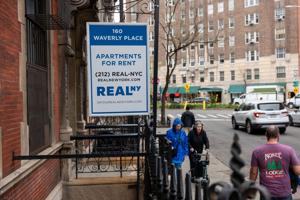
If you rent your home in a major metro area, chances are you already know this hard truth: Your pay raises aren’t keeping up with your rent hikes.
A new analysis released on Tuesday by the rental website StreetEasy and its parent company Zillow found that rent growth has surpassed wage growth in 44 out of the 50 largest U.S. metros since before the pandemic. The report analyzed rental data from both company sites as well as wage growth data from the Bureau of Labor Statistics.
What’s driving rent price growth? Nicole Bachaud, senior economist at Zillow, chalks it up to a combination of low inventory of homes for purchase, high costs of homeownership and few rentals available all putting pressure on the rental market. And it’s not just high prices keeping people in their rental homes — mortgage rates are also elevated, which increases the cost of buying a home.
“When we look at why we have so many renters and so much demand for rentals right now, it’s not for lack of people wanting to buy homes — it’s for the lack of ability to be able to buy homes,” says Bachaud. “There are no homes available to buy and the ones that are available are oftentimes unaffordable for the majority of potential buyers.”
What’s happening to rent in major cities?
The current state of the rental market in most major cities is the result of the pandemic’s impact on the overall housing market, says Bachaud.
At the start of the pandemic, she says, there was a ton of demand for homebuying due to low interest rates, but there weren’t enough homes available to purchase. That low inventory has stayed low. During the same period, the Federal Reserve hiked the federal funds rate, which pushed up mortgage rates. This heightened cost of homeownership has kept more people in the rental market, and until homebuying conditions improve, they’re likely to stay renters.
Biding your time in the rental market makes sense for a lot of people — and it’s the sensible thing to do on an individual level. The problem is that the more people who remain in a rental market with an existing inventory problem, the more pressure it puts on prices. When wages can’t keep up with the pace of rent growth, those rental markets become even more unaffordable. And that’s just what happened, according to the report: Nationwide, rents grew 30.4% from 2019 to 2023, about 1.5 times faster than wages, which grew 20.2%.
What are the most unaffordable metro areas?
“For the most part, in most of the country, wages have not been able to keep up with rent prices,” says Bachaud. “That is extremely true in Florida and in New York.”
From 2019 to 2023, two metros in Florida saw huge disparities between wage growth and rent growth: Tampa (34.7 percentage point difference) and Miami (32.2 percentage point difference).
“During the past few years, we had a lot of people looking at what Florida has to offer with sunny weather, outdoor living, and it was relatively affordable compared to other and coastal areas,” says Bachaud. “That threw a lot of renters into that area, which has really kept a lot of the pressure on, on rents, for the past couple of years.”
When it comes to rent unaffordability, New York City leads the pack by a long shot. At the start of the pandemic, New York City was at the epicenter. As droves of renters left the city, rent prices dropped, but as soon as services and offices began to reopen, demand to rent and buy homes in the city skyrocketed — an upward trend that hasn’t slowed in recent years, says Bachaud.
From 2022 to 2023, New York City wages grew 1.2% as rents spiked 8.6% — that’s seven times as fast. The report cites record low vacancy rates and high demand for the spike in rent growth.
Bachaud says, “We have about seven times faster growth in rent in New York City, which is extremely problematic for New York renters who are trying to keep pace with these growing prices because they just do not have the income growth to sustain that.”
To add to this discouraging picture of rent affordability, three of the nation’s largest metro areas — Boston, Chicago and Memphis, Tennessee — actually saw wage growth decline from 2022 to 2023 even as rent prices climbed.
Some metros are seeing wages grow faster than rent
However, the rental affordability outlook isn’t all doom and gloom. From 2022 to 2023, Houston saw rents increase more slowly than wages (5.3 percentage point difference). Another Texas city, Austin, has also seen wages outpace rents (4.7 percentage point difference), largely due to new construction, says Bachaud.
“Austin has just been off the charts with new construction, both in the for-sale and the rental side,” she says. “And so that’s been really, really helpful for renters to kind of stay afloat in that area.”
Since 2019, six metro areas saw wages outstrip rents, including San Francisco and nearby San Jose — two of the most expensive metros in the country: a 5.8 percentage point difference in San Francisco and a 5.3 percentage point difference in San Jose.
“You may think San Francisco and San Jose are going to be the most unaffordable given they’re the highest priced, but incomes are very high in that area as well,” says Bachaud.
There are signs of a rental rate slowdown ahead for many other metro areas. When isolating for a one-year period, from 2022 to 2023, wages have increased faster than rents in 21 of the 44 major metro areas. The highest wage increases compared with rents in that period are in San Jose (5.8 percentage point difference); Houston (5.3 percentage point difference); and Raleigh, North Carolina (3.8 percentage point difference).
Rent growth is slowing even if inflation data doesn’t show it yet
Even if rents are outpacing wages, the rental market is stabilizing. “We’re seeing rents return to normal levels of growth,” says Bachaud. “Last year, rents grew 3.4% — it’s a lot lower than when it was 20% or 30%.”
New multifamily construction will likely be a big part of the price slowdown. “Adding more rental availability is going to take a lot of that pressure off of the demand for things, and we’re going to have more opportunities for rentals coming up shortly in the future,” she says.
A year ago, Zillow predicted that inflation data, namely the consumer price index, would soon start to show rent prices cooling off. Due to the nature of rental leases, there’s typically a 12- to 15-month lag in how current rents are reflected in inflation data. So that hasn’t happened yet.
“While we’re seeing things slowing down and getting back to normal, we still do have positive rent growth,” says Bachaud. “That doesn’t look like it’s going away anytime soon, we’re just kind of back in the normal range. And so we kind of expect, hopefully within the next couple of months, to see that translating into inflation, as well.”
More From NerdWalletRental Market Trends in the U.S.How Much Should I Spend on Rent?Rent vs Buy Calculator
Anna Helhoski writes for NerdWallet. Email: anna@nerdwallet.com. Twitter: @AnnaHelhoski.
The article Rent Growth Outstrips Wages in Most U.S. Metros, New Report Shows originally appeared on NerdWallet.


